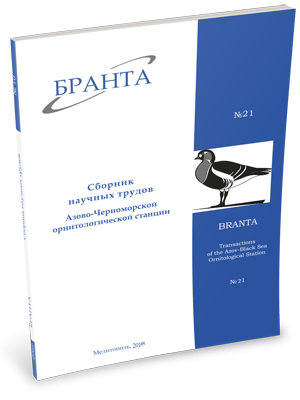
Transactions
of the Azov-Black Sea Ornithological Station



The birds of Yagorlyk reserve’s wetlands
A. А. Tischenkov
The article deals with the information about wetland birds of Yagorlyk Nature Reserve, their nature stay, number, protection status, the dates of registration of rare species and other information on the ecology and distribution of birds in reserve’s wetlands.
The total list of wetland birds of the Yagorlyk Reserve includes 72 species. These birds belong to 11 orders and 21 families: ord. Gaviiformes – 1 species; Podicipediformes – 2; Pelicaniformes - 2; Ciconiiformes - 9; Anseriformes -18; Falconiformes - 3; Gruiformes - 5; Charadriiformes - 16; Cuculiformes - 1; Coraciiformes – 1; Passeriformes - 14 species.
66 species of wetland birds have been registered here in 1996-2016. Over the past 20 years 26 species of wetland birds nested in the reserve with various regularity. Great Reed Warbler and Moorhen are dominant. Also Savi's Warbler, Penduline Tit, Common Coot, Sedge Warbler, Common Cuckoo, Common Kingfisher, Water Rail, Great Crested Grebe, Little Bittern, Mallard, Spotted Crake, Reed Warbler and Reed Bunting were numerous or usual nesting birds of reserve’s wetlands.
Only during migrations 22 species were observed here. During the migration periods the most numerous were: Mallard, Common Coot, Moorhen, Garganey, Penduline Tit, Black-headed Gull, Bearded Tit and other. In winter 21 species of wetland birds (Mallard dominated) were observed. Meetings of Ospley, Green Sandpiper and Common Snipe were the most interesting in winter.
Many wetland birds of the reserve are included in the various protection lists and Red Books: IUCN – 3 species; Birds Directive EU 79/409/EEC – 49; Bern Convention – 41; Bonn Convention – 43; Red Book of Dniester Moldavian Republic – 11; Red Book of Moldova – 15; Red Book of Ukraine – 11 species. The majority of rare species of birds are met in the reserve during migrations: Pygmy Cormorant, Great White Egret, Black Stork, Ferruginous Duck, Red-breasted Merganser, Ospley, White-tailed Eagle, Aquatic Warbler, Bluethroat and other.
In varying degrees, 103 species of birds are associated with wetlands of Yagorlyk Reserve.
References:
- Arkhipov, A. M. (2001). Bluethroat Luscinia svecics – a new nesting type of Cuciurgan reservoir. Branta: Transactions of the Azov-Black Sea Ornithological Station, 4, 120‑121. [in Russian]
- Averin, Y. V., & Ganya, I. M. (1970). Birds of Moldova (Vol. 1). Kishinev: Printing and publication department of the Academy of Sciences of the Moldavian SSR. [in Russian]
- Averin, Y. V, Ganya, I. M & Uspenskiy G.A. (1971). Birds of Moldova (Vol.2). Kishinev: Shtiintsa. [in Russian]
- Belik, V. P. (2000). Birds of the steppe Pridon’ye: formation of fauna, its anthropogenic transformation and protection issues. Rostov-on-Don: Publishing house of Herzen Sate Pedagogical University of Russia. [in Russian]
- Bogatyy, D. P. (2016). Distribution of macrozoobenthos in the water area of the reserve “Yagorlyk” in 2010–2015. Academician Leo Berg – 140, 310–312. [in Russian]
- Vinogradov, V. V. & Reutskiy N. D. (1983). New data on wintering of birds in reed biogeocenoses of the Volga Delta. Ornithology, 18, 188–189. [in Russian]
- Grishchenko, V. N. (1997). Biotechnical measures for the protection of rare bird species. Chernivtsi. [in Russian]
- Nature reserve “Yagorlyk”. Reconstruction and management plan as a way of biodiversity conservation (2011). Kishinev: Eco-Tiras. [in Russian]
- Zubkov, N. I., Buchuchanu, L. S., & Curkanu, V. F. (1999). Ornithological and Herpetological complexes of the nature reserve “Yagorlyk”. Biodiversity Conservation of the Dniester River Basin, 76–78. [in Russian]
- Korzyukov, A. I., Trifonov, V. G., & Koval’, L. K. (1999). Present state of Bluethroat in Odessa region. Branta: Transactions of the Azov-Black Sea Ornithological Station, 2, 185–189. [in Russian]
- Red book of the Pridnestrovian Moldavian Republic (2009).Tiraspol.
- Kuzyakin, A. P. (1962). Zoogeography of the USSR. Scientific Notes of the Moscow Region State University:Biogeography, 109(1), 3–182. [in Russian]
- Stepanyan, L. S. (1990). Outline of ornithological fauna of the USSR. Moscow: Nauka. [in Russian]
- Tishchenkov, A. A. (2002). Unusual meeting times of birds in the near Dniester region. Branta: Transactions of the Azov-Black Sea Ornithological Station, 5, 162–165. [in Russian]
- Tishchenkov, A. A. & Aptekov, A. A. (2001). Meetings of some rare birds in Transnistria in 2000–2001. Berkut, 10(2), 153-155. [in Russian]
- Tishchenkov, A. A., Romanovich, N. A., Zotik, Yu. E., Medvedenko, D. V., Stakhurskaya, E. S., Pershina, V. I., Aptekov, A. A. & Filipenko, S. I. (2016). Meetings of some rare birds in Transnistria in 2012-2015. Strepet, 14 (1–2), 65–76. [in Russian]
- Red Data Book of Ukraine. Animal world (2009). Kyiv: Global Consulting. [in Ukrainian]
- Cartea Roşie a Republicii Moldova. Ed. a 3-a. (2015). Chişinau: Î.E.P. Ştiinţa.